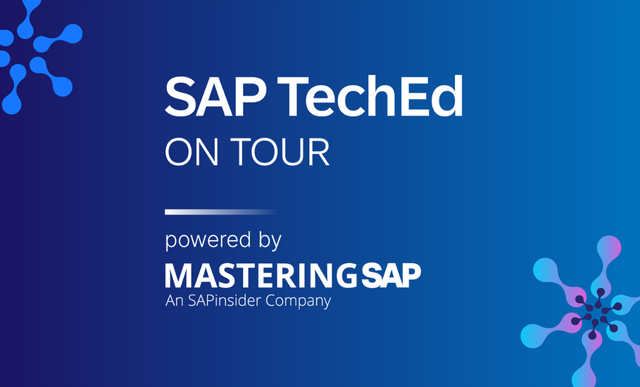SAP COPA
Filter By
Browse By
- SAP Analytics and AI
- SAP Application Development and Integration
- All SAP Application Development and Integration
- SAP ABAP
- SAP ABAP Development Tools
- SAP ABAP Test Cockpit
- SAP API Management
- SAP BAPI
- SAP Basis
- SAP BRF
- SAP Business Application Studio
- SAP CMS
- SAP Design Studio
- SAP Development Tools
- SAP DevOps
- SAP EAI
- SAP EDI
- SAP Extension Suite
- SAP Fiori
- SAP Fiori Elements
- SAP Integration Suite
- SAP Low Code Application Development
- SAP Low Code Automation
- SAP Netweaver
- SAP Release Management
- SAP UI5
- SAP Web Application Server
- SAP Web IDE
- SAP Business Process Management
- SAP Center of Excellence
- SAP CIO
- SAP Customer Experience
- SAP Data and Data Management
- All SAP Data and Data Management
- SAP BW
- SAP BW/4HANA
- SAP Crystal Reporting
- SAP Data Archiving
- SAP Data Center
- SAP Data Governance
- SAP Data Integration
- SAP Data Migration
- SAP Data Quality
- SAP Data Services
- SAP Data Strategy
- SAP Data Visualization
- SAP Data Warehouse Cloud
- SAP DMS
- SAP Document Control
- SAP EIM
- SAP ETL
- SAP ETL Tools
- SAP HANA
- SAP HANA Administration
- SAP HANA Deployment Infrastructure
- SAP HANA Studio
- SAP Master Data
- SAP Master Data Governance
- SAP MDM
- SAP Enterprise Architect
- SAP Enterprise Asset Management
- SAP ERP
- SAP Finance
- All SAP Finance
- SAP Accounting
- SAP AR AP
- SAP Asset Accounting
- SAP Billing Systems
- SAP BPC
- SAP BRIM
- SAP Cash Management
- SAP Central Finance
- SAP Controlling
- SAP COPA
- SAP Cost Center Accounting
- SAP e-invoicing
- SAP FICO
- SAP Finance Automation
- SAP Financial Closing Cockpit
- SAP Financial Consolidation
- SAP Financial Planning
- SAP FX Risk
- SAP General Ledger
- SAP Global Tax Management
- SAP Hyperion
- SAP Order to Cash
- SAP Payment Processing
- SAP Profitability Analysis
- SAP Rebate Management
- SAP S/4HANA Finance
- SAP Universal Journal
- SAP Governance Risk and Compliance
- SAP Human Capital Management
- SAP Intelligent Technologies
- SAP Platform and Technology
- All SAP Platform and Technology
- SAP Business Technology Platform
- SAP Cloud Connector
- SAP Cloud Integration Platform
- SAP Cloud Migration
- SAP Cloud Platform
- SAP Cloud Providers
- SAP Cloud Strategy
- SAP Container Platform
- SAP Digital Asset Management
- SAP Digital Integration Hub
- SAP Digital Signature
- SAP HANA Enterprise Cloud
- SAP HEC
- SAP Hyperscalers
- SAP Infrastructure
- SAP Messaging
- SAP Smart Forms
- SAP Quality and Testing
- SAP Security
- SAP Spend Management
- SAP Supply Chain Management
- All SAP Supply Chain Management
- SAP APO
- SAP Asset Management
- SAP Business Network
- SAP Digital Manufacturing Cloud
- SAP Digital Twin
- SAP EWM
- SAP IBP
- SAP Inventory Management
- SAP Label Printing
- SAP Logistics
- SAP Manufacturing
- SAP Manufacturing Automation
- SAP MES
- SAP MII
- SAP MM
- SAP MRO
- SAP MRP
- SAP Order Management
- SAP Plant Maintenance
- SAP PLM
- SAP Production Planning
- SAP S&OP
- SAP SD
- SAP SPM
- SAP Supply Chain Planning
- SAP Track and Trace
- SAP Transportation Management
- SAP System Administration
What is SAP COPA?
SAP COPA (Controlling – Profitability Analysis) is a critical component of the SAP ERP Financials solution. It provides comprehensive functionality for financial consolidation, planning, and performance management. SAP COPA enables customers to centrally manage their financial performance and comply with statutory and regulatory requirements. SAP COPA is an essential module for SAP customers who want to improve their financial planning and execution.
What is SAP COPA?
SAP COPA (Controlling – Profitability Analysis) is a critical component of the SAP ERP Financials solution. It provides comprehensive functionality for financial consolidation, planning, and performance management. SAP COPA enables customers to centrally manage their financial performance and comply with statutory and regulatory requirements. SAP COPA is an essential module for SAP customers who want to improve their financial planning and execution.
SAP COPA provides two choices for implementation for SAP customers: one based on account codes (account-based SAP COPA) and another based on costing (costing-based SAP COPA), which is done by measuring value fields or key figures.
Key capabilities include:
- Financial planning and forecasting
- Actual vs. budget comparisons
- Profitability analysis
- Management of margins and profitability
- Cost allocation and product costing
- Financial reporting
Key Considerations for SAPinsiders
Plan for the switch to account-based COPA in SAP S/4HANA Finance. Organizations planning a migration to SAP S/4HANA should understand the advantages and disadvantages of choosing one SAP COPA option over another. In addition, business processes will likely change during a switchover from costing-based SAP COPA to account-based SAP COPA, so it’s important to evaluate change management in concert with any business process updates that trigger a potential SAP process redesign.
Explore SAP COPA capabilities and integrations with SAP applications to extend functionality. Organizations using SAP COPA can leverage SAP Fiori support and integration with other SAP applications to provide finance and accounting teams with flexibility. Integration with the SAP General Ledger enables accurate data for analyzing financial performance and profitability at the organizational level.
Consider an implementation partner with experience in SAP ERP Financials and SAP COPA implementations.Collaborating with proven SAP experts who understand business process flows and the associated COPA requirements can help fill the gap caused by a challenging employment environment. In addition, finance and accounting teams should confirm that the correct SAP COPA settings are in place, including the configuration of journals, account determination, and Profit Center Accounting.
507 results
-

SAP S/4HANA on Your Own Terms: Shaping the Right Migration Strategy
August 27, 2025
With SAP ECC support ending soon, many organisations are under pressure to plan a well-informed transition to SAP S/4HANA. While system conversion (Brownfield) and re-implementation (Greenfield) remain the traditional approaches, a third path, Selective Data Transition (SDT), is increasingly being considered, particularly for businesses with complex system landscapes or requirements to retain selected historical data.…
-

Use Your Program Variants More Effectively with the Help of TVARV Variables
Published: 15/March/2005
Reading time: 111 mins
Instead of manually changing the selections in a program variant, you can make the system change the variant values automatically. This saves time, especially if you are running hundreds of reports. Key Concept Selection variables fall into three categories: Date variables (D): Say that you run a daily sales analysis report, with the date parameter...…
-

Reconcile Costing-Based CO-PA with FI and Generate Full Product-Level P&L Reports
Published: 24/October/2013
Reading time: 15 mins
Ashim Nanda explains how to reconcile costing-based Profitability Analysis (CO-PA) with FI using the G/L account as a characteristic. Key Concept SAP Profitability Analysis (CO-PA) supports two forms of profitability computation: costing based and account based. Account-based CO-PA reconciles with FI, whereas costing-based CO-PA has higher flexibility and computational capabilities that provide businesses with supporting...…
-
-

Tips and Tricks from the Trenches
Published: 15/January/2002
Reading time: 4 mins
This is a monthly column where SAP Financials product manager, Gary Fullmer, shares tips and tricks from SAP experts, including SAP product managers and SAP consultants, on ways current FI/CO capabilities can be more fully utilized and expanded. For this first column, a senior FI/CO configurator and former SAP FI/CO platinum consultant discusses some useful...…
-

A Holistic Approach to Implementing Central Finance
Published: 28/October/2016
Reading time: 24 mins
Learn tips to help you prepare for a Central Finance implementation project. Central Finance is aimed at reducing the cost of adoption of SAP S/4HANA Finance for organizations having heterogeneous landscapes (multiple SAP ERP or non-SAP systems). With Central Finance, these organizations no longer have to upgrade all the systems to have SAP S/4HANA Finance....…
-

Ask the SAP Financials Expert: How Do I Retrieve and Display Archived CO-PA Line Items?
Published: 15/June/2005
Reading time: 19 mins
Standard SAP archiving methods do not allow you to retrieve specific Profitability Analysis (CO-PA) line items. However, you can gain access to them via two methods: using the SAP Archiving Information System or ABAP code. Each has limitations you should know about. Key Concept Dear SAP Financials Expert, Our Profitability Analysis (CO-PA) database is...…
-

Use Top-Down Distribution in CO-PA to Report Overhead Costs at Lower-Level Characteristics
Published: 15/June/2010
Reading time: 11 mins
Discover top-down distribution functionality and execution in day-to-day operations with two business examples. The first explains the allocation of expenses from cost centers to material groups through profitability analysis (CO-PA) assessment, with material group being a higher-level characteristic. The second explains how to distribute these expenses, posted through CO-PA assessments, from material group to material...…
-
-

Comply with Sarbanes-Oxley Regulations by Locking Posting Periods in CO-PA
Published: 15/May/2007
Reading time: 11 mins
Discover how to use the Profitability Analysis (CO-PA) valuation enhancement to lock posting periods against changes in CO-PA data. See also how this solution helps meet Sarbanes-Oxley compliance for internal controls on CO-PA reporting. Key Concept Valuation is a key capability of costing-based Profitability Analysis (CO-PA) that the system uses to automatically fill value fields...…
-

Get the Most Out of SAPSprint for Server-Based Printing in Microsoft Windows
Published: 22/April/2009
Reading time: 19 mins
SAPSprint is the latest service for server-based printing on Windows. Learn how to install and configure this service with its default options. Drill down into the technical implementation to learn how to manage print requests, restart print processes, configure front-end printing, and include barcodes. Key Concept Processing in SAPSprint means generating print data via the...…
-

Explore Your SAP S/4HANA Implementation Options
Published: 01/November/2016
Reading time: 34 mins
SAP S/4HANA experts answered user questions during two one-hour live chat sessions. The panelists included members of the SAP Digital Business Services organization and an SAP partner organization leading digital transformation projects with customers. Questions ranged from topics such as building a business case for SAP/4HANA to custom code to BW on HANA. Read the…
Featured Experts
-

Clifford Seckman
President, Virginia Software Group, Inc.
Become a Member
Unlimited access to thousands of resources for SAP-specific expertise that can only be found here.
Upcoming Events
-

Mastering SAP Collaborate an SAP TechEd on Tour event
November 12 - 14, 2025
Sydney, New South Wales
Australia
View Event
Your request has been successfully sent